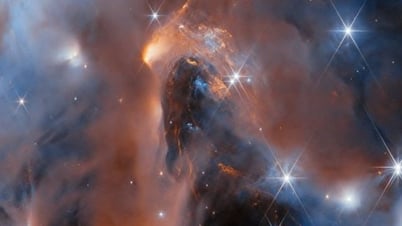According to The Astrophysical Journal Letters, the James Webb and Very Large telescopes have observed a free-floating planet sucking in material at a record rate, exhibiting behavior similar to the star formation process.
Although many similar planets have been discovered before, the new planet, named Cha 1107-7626, is completely different.
According to observations from the Telescope, this is the fastest growing free planet ever known, "eating" matter at a rate of up to 6.6 billion tons per second.
According to the research team, this discovery could help scientists better understand the boundary between a giant planet and a small star, because both are formed from the process of sucking matter (accumulating mass).
"Our main motivation in studying this type of object is to determine whether they were originally planets that were ripped from their parent star systems, or formed independently due to the gravitational collapse of molecular clouds," said astronomer Víctor Almendros-Abad, Palermo Astronomical Observatory.
The team discovered an "accretion burst," a phenomenon that occurs when a planet suddenly sucks in a large amount of material from the surrounding disk of gas and dust.

Artist's illustration of the Cha 1107-7626 deposit. (Photo: Kornmesser).
Cha 1107-7626 continues to absorb this matter, but at an unstable rate. In August 2025, its accumulation rate was eight times higher than it had been a few months earlier.
The accretion burst phenomenon suggests that rogue planets may behave like young stars, as similar "famines" have been recorded in stars.
However, because planets are much smaller than stars, scientists are still unclear at what point their formation paths begin to diverge.
"We know that these outbursts play an important role in star formation and influence the environment in which planetary systems form, by heating the gas and dust clouds surrounding young stars," said Professor Alexander Scholz, University of St. Andrews.
Traces of these explosions are found in the chemical composition of meteorites in the Solar System, he added.
In recent years, the number of rogue planets discovered has increased dramatically, thanks in particular to JWST, which has discovered more than 500 of these planets.
The team hopes the two telescopes will continue to observe many more wandering planets, to determine whether they formed by stellar or planetary mechanisms.
Scientists will continue to investigate how common accretion bursts are on these types of planets, to understand the importance of accretion events in their evolution.
Source: https://dantri.com.vn/khoa-hoc/phat-hien-hanh-tinh-ky-la-nuot-chung-6-ty-tan-vat-chat-moi-giay-20251108223017160.htm







![[Photo] Cutting hills to make way for people to travel on route 14E that suffered landslides](https://vphoto.vietnam.vn/thumb/1200x675/vietnam/resource/IMAGE/2025/11/08/1762599969318_ndo_br_thiet-ke-chua-co-ten-2025-11-08t154639923-png.webp)





























![[Video] Hue Monuments reopen to welcome visitors](https://vphoto.vietnam.vn/thumb/402x226/vietnam/resource/IMAGE/2025/11/05/1762301089171_dung01-05-43-09still013-jpg.webp)




































































Comment (0)